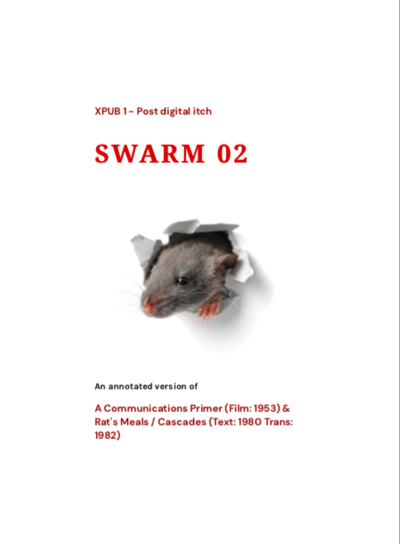User:Golubjevaite/Methods I I: Difference between revisions
Golubjevaite (talk | contribs) |
Golubjevaite (talk | contribs) |
||
| Line 82: | Line 82: | ||
==reading list== | ==reading list== | ||
Massimo Banzi & Michael Shiloh - Make: Getting started with Arduino<br> | Massimo Banzi & Michael Shiloh - Make: Getting started with Arduino<br> | ||
Judith Butler - Bodies That Matter | |||
<br> Judith Butler - Gender Trouble | <br> Judith Butler - Gender Trouble | ||
<br> [https://www.researchgate.net/publication/240740399_Philosophy_and_Literature_The_Fortunes_of_the_Performative Jonathan Culler: Fortunes of the Performative] | <br> [https://www.researchgate.net/publication/240740399_Philosophy_and_Literature_The_Fortunes_of_the_Performative Jonathan Culler: Fortunes of the Performative] | ||
Latest revision as of 12:39, 20 April 2020
SPECIAL ISSUE 11
INTENSIVES
SWARMS
reading list
Jacques Derrida - Archive Fever: Freudian Impression
Michel Serres - Rat's Meals / Cascades
Alessandro Ludovico - Post-Digital print
Eric Schrijver - Copy This Book
Femke Snelting - Conversations
Simon Monk - Programming the Raspberry Pi: Getting started with Python
[Andy Greenberg - This machine kills secrets]
SPECIAL ISSUE 10
2
PAD 20191009]
1)Method: annotate text or make synopsis of text.
or
2)Method: Account of work done.
A practical What How Why
What do we want it to mean,
why should we care?
~300 words
To come to grips with the topics! What is at stake?
What
Getting familiar with modular synth w. Exploring possibilities and limitations.
introduction to UNIX, GIT, ARDUINO, WIKI.
history, structure, language, how and why it is usefull
How
learning different code definitions, commands, accessing “the machine” (laptop, synth) through a different entrance.
assembling and soldering a Meergranen modular synth from scratch or/from the provided parts/.
Introducing hands with materials and shape, functionality.
Why
in order to understand “the machine” and gain control back? training the critical inner eye and being able to recognize and propose ?
Language equals structure to me. ORIGIN of this structure interest me in order to UNDERSTAND.
In order to understand I need to know where it begins.
important to share the doubts and questions and perhaps propose rather than decide
formal language (rules, grammar, definitions) - difficult.
programming language (commands) - easy.
-Natural language
-Formal language
-Computational linguistics
-Constructed language
-Fictional language
…...... . . .
machine as a manipulator - audio-visual synthesis - using the same approach but to manipulate something different than pure sound - interested in the relationship between the machines output and the underlaying software/code as a language, structure, meanings -
Writing resulting in an action on the world
Language as an interface
1
Todays task: what, how, why.
Outcome 150 word text describing a piece of work you made. (X2 = 300 words)
what 50 words
<object>
how 50 words
<method>
why 50 words
<motivation>
reading list
Massimo Banzi & Michael Shiloh - Make: Getting started with Arduino
Judith Butler - Bodies That Matter
Judith Butler - Gender Trouble
Jonathan Culler: Fortunes of the Performative
J. L Austin - How to do Things with Words
Kate Briggs - The little Art
Florian Cramer - Words Made Flesh
Douglas Rushkoff - Program or Be Programmed
Matthew Fuller - Sotware studies\ a lexicon
Matthew Fuller - Blip
Alexander Galloway - The Interface Effect
Alexander Galloway - Protocol
N.Katherine Hayles - Writing Machines
Jack Goody - The interface between the written and the oral
Friedrich A. Kittler - Essays
Ong Walter - Orality and literacy

